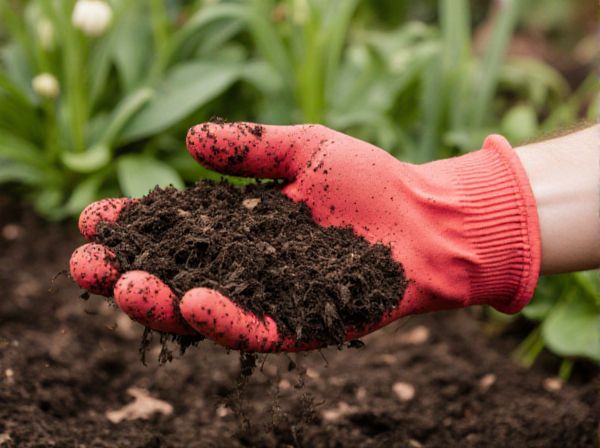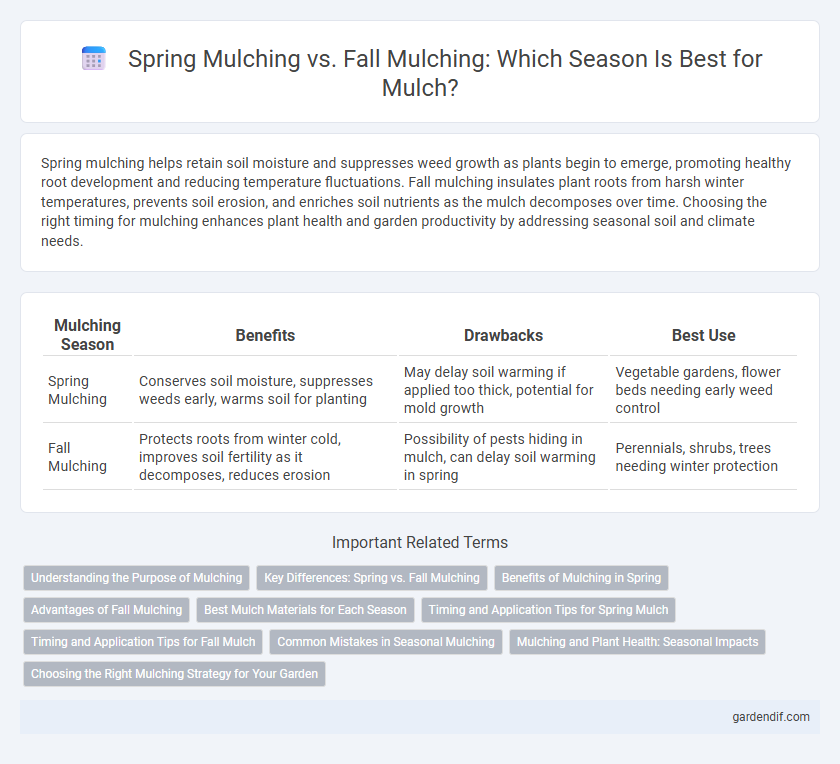
Spring mulching vs Fall mulching Illustration
Spring mulching helps retain soil moisture and suppresses weed growth as plants begin to emerge, promoting healthy root development and reducing temperature fluctuations. Fall mulching insulates plant roots from harsh winter temperatures, prevents soil erosion, and enriches soil nutrients as the mulch decomposes over time. Choosing the right timing for mulching enhances plant health and garden productivity by addressing seasonal soil and climate needs.
Table of Comparison
| Mulching Season | Benefits | Drawbacks | Best Use |
|---|---|---|---|
| Spring Mulching | Conserves soil moisture, suppresses weeds early, warms soil for planting | May delay soil warming if applied too thick, potential for mold growth | Vegetable gardens, flower beds needing early weed control |
| Fall Mulching | Protects roots from winter cold, improves soil fertility as it decomposes, reduces erosion | Possibility of pests hiding in mulch, can delay soil warming in spring | Perennials, shrubs, trees needing winter protection |
Understanding the Purpose of Mulching
Spring mulching promotes soil moisture retention and temperature regulation, fostering healthy root growth and protecting emerging plants from temperature fluctuations. Fall mulching insulates the soil, reduces erosion, and minimizes frost heaving, safeguarding perennials and soil microorganisms during winter dormancy. Effective mulching timing aligns with seasonal plant needs, enhancing nutrient availability and soil structure for optimal garden health.
Key Differences: Spring vs. Fall Mulching
Spring mulching helps retain soil moisture, suppresses weed growth, and warms the soil for optimal plant growth during the growing season. Fall mulching, on the other hand, insulates plant roots, reduces soil erosion, and conserves soil moisture during colder months. Key differences include timing related to plant growth cycles and specific benefits such as warming in spring versus insulation in fall.
Benefits of Mulching in Spring
Spring mulching promotes soil moisture retention, reducing the need for frequent watering during the growing season. It enhances soil temperature regulation, supporting early root development and plant growth. Applying mulch in spring also suppresses weed emergence, minimizing competition for nutrients and improving garden health.
Advantages of Fall Mulching
Fall mulching enhances soil moisture retention and temperature regulation, preparing plants for winter dormancy while reducing erosion and weed growth. Nutrients from decomposing mulch enrich the soil, promoting stronger root development and healthier spring growth. This practice also protects perennials from frost damage and supports beneficial soil organisms during colder months.
Best Mulch Materials for Each Season
Spring mulching benefits from organic materials like shredded bark, straw, and composted leaves that help retain moisture and encourage early root growth. Fall mulching prefers hardwood chips, pine needles, or straw to insulate soil, protect roots from freezing, and reduce winter weed growth. Choosing season-appropriate mulch materials optimizes soil health, moisture retention, and temperature regulation for thriving plants.
Timing and Application Tips for Spring Mulch
Applying mulch in spring, typically between March and early May, helps conserve soil moisture, suppress weeds, and insulate emerging plants from temperature fluctuations. For optimal results, apply a 2-3 inch layer of organic mulch such as shredded bark or compost, avoiding direct contact with plant stems to prevent rot. Timing mulch application after soil has warmed encourages healthy root growth and enhances nutrient retention throughout the growing season.
Timing and Application Tips for Fall Mulch
Applying mulch in the fall helps protect plant roots from winter temperature fluctuations by insulating the soil and retaining moisture. Timing is critical; apply mulch after the first frost but before the ground freezes to maximize insulation and prevent early weed growth. Use a 2 to 4-inch layer of organic material such as shredded leaves or bark, avoiding excessive thickness that can cause moisture buildup and root rot.
Common Mistakes in Seasonal Mulching
Spring mulching often suffers from applying too thick a layer, which can suffocate emerging plants and trap excess moisture, leading to root rot. Fall mulching mistakes include neglecting to remove diseased plant material before applying mulch, which can harbor pests and diseases over winter. Both seasons demand proper mulch depth, ideally 2-4 inches, to optimize soil temperature and moisture while preventing compaction and pest infestation.
Mulching and Plant Health: Seasonal Impacts
Spring mulching enhances soil moisture retention and temperature regulation, promoting early root growth and reducing weed competition during the growing season. Fall mulching insulates roots against freezing temperatures, prevents soil erosion, and supports microbial activity critical for nutrient cycling over winter. Proper seasonal mulching improves plant health by optimizing soil conditions tailored to plants' physiological needs during different growth phases.
Choosing the Right Mulching Strategy for Your Garden
Spring mulching promotes soil moisture retention and weed suppression, enhancing early plant growth by warming the soil and maintaining consistent temperatures. Fall mulching protects roots from frost damage, improves soil organic matter as it decomposes, and prevents soil erosion during heavy rains. Selecting between spring and fall mulching depends on your plant species, climate zone, and specific garden goals to optimize growth and soil health year-round.
Spring mulching vs Fall mulching Infographic

 gardendif.com
gardendif.com